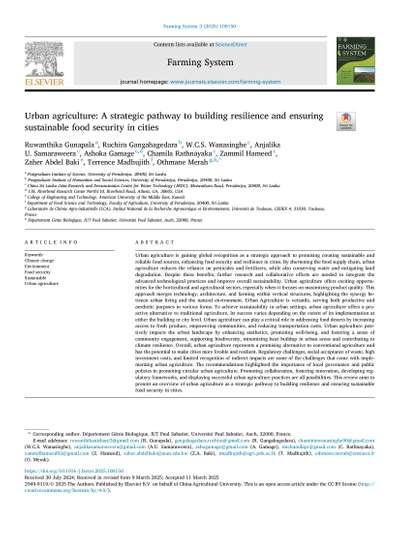2 Issues in this Publication (Showing 1 - 2)
Urban agriculture: A strategic pathway to building resilience and ensuring sustainable food security in cities - 2025-01-20
Ruwanthika Gunapala, Ruchira Gangahagedara, W.C.S. Wanasinghe, Anjalika U. Samaraweera, Ashoka Gamage, Chamila Rathnayaka, Zammil Hameed, Zaher Abdel Baki, Terrence Madhujith, Othmane Merah, Urban agriculture: A strategic pathway to building resilience and ensuring sustainable food security in cities, Farming System, Volume 3, Issue 3, 2025, 100150, ISSN 2949-9119, https://doi.org/10.1016/j.farsys.2025.100150. (https://www.sciencedirect.com/science/article/pii/S2949911925000140)
Abstract: Urban agriculture is gaining global recognition as a strategic approach to promising creating sustainable and reliable food sources, enhancing food security and resilience in cities. By shortening the food supply chain, urban agriculture reduces the reliance on pesticides and fertilizers, while also conserving water and mitigating land degradation. Despite these benefits, further research and collaborative efforts are needed to integrate the advanced technological practices and improve overall sustainability. Urban agriculture offers exciting opportunities for the horticultural and agricultural sectors, especially when it focuses on maximizing product quality. This approach merges technology, architecture, and farming within vertical structures, highlighting the synergy between urban living and the natural environment. Urban Agriculture is versatile, serving both productive and aesthetic purposes in various forms. To achieve sustainability in urban settings, urban agriculture offers a proactive alternative to traditional agriculture. Its success varies depending on the extent of its implementation at either the building or city level. Urban agriculture can play a critical role in addressing food deserts by increasing access to fresh produce, empowering communities, and reducing transportation costs. Urban agriculture positively impacts the urban landscape by enhancing aesthetics, promoting well-being, and fostering a sense of community engagement, supporting biodiversity, minimizing heat buildup in urban areas and contributing to climate resilience. Overall, urban agriculture represents a promising alternative to conventional agriculture and has the potential to make cities more livable and resilient. Regulatory challenges, social acceptance of waste, high investment costs, and limited recognition of indirect impacts are some of the challenges that come with implementing urban agriculture. The recommendations highlighted the importance of local governance and public policies in promoting circular urban agriculture. Promoting collaboration, fostering innovation, developing regulatory frameworks, and displaying successful urban agriculture practices are all possibilities. This review aims to present an overview of urban agriculture as a strategic pathway to building resilience and ensuring sustainable food security in cities.
Keywords: Climate change; Environment; Food security; Sustainable; Urban agriculture
Multicriteria assessment of recently implemented conservation agriculture cropping systems across farmers’ plots in northwestern Cambodia - 2025-01-20
Sambo Pheap, Alexis Thoumazeau, Jun Murase, Vang Seng, Jean-Pierre Sarthou, Veng Sar, Linda Kimbo, Soklin Kheam, Pheakdey Chan, Pao Srean, Samrith Leang, Lyda Hok, Florent Tivet, Multicriteria assessment of recently implemented conservation agriculture cropping systems across farmers’ plots in northwestern Cambodia, Farming System, Volume 3, Issue 2, 2025, 100140, ISSN 2949-9119, https://doi.org/10.1016/j.farsys.2025.100140. (https://www.sciencedirect.com/science/article/pii/S2949911925000048)
Abstract: Soil fertility depletion is a major challenge for annual rainfed cropping systems in the northwestern region of Cambodia which has recently undergone rapid agrarian changes. On-farm impacts of conventional tillage and Conservation Agriculture-based practices (CT and CA respectively) of maize cultivation on soil health along with agronomic and economic performances were compared. The experiment was set up in 2020 comparing CT and CA with one cover crop (CAS) and CA with a mix of three cover crops (CAM). Soil health was assessed at the end of the cropping cycle using Biofunctool®. Agronomic performances including cover crops and a cash crop (maize) along with intermediate consumption were recorded in 2021 and 2022. Selected components of soil health, agronomic and economic performances were used for multi-criteria analysis. On this Mollisols, SHI was positively impacted under CA (15% and 6% higher in 2021 and 2022), but with some soil parameters varied from one year to the next. In 2021, lower plant density (p < 0.05) was recorded under CA, highlighting the need to improve the efficiency of no-till sowing methods. Intermediate consumption was not significant between the treatments for both years. Non-significant difference in yields was recorded under the three treatments in both years, but while both CA systems remained stable, CT dropped by 10% in 2022 with some differences for yield components with a larger number of grains per column and higher mass of grains under CAS. Gross value added under CA was 12.7% less than CT in 2021, it surpassed CT by 43% in 2022. Agronomic and economic performances were still unstable at this early stage of implementation with wide variability across the two cropping seasons emphasizing that with this soil type, CA induced a significant increase in soil health but did not yet lead to significant increase in productivity or economic outcomes.
Keywords: Mollisols; Soil health; Agricultural practices; Field-scale analysis; Agricultural productivity

